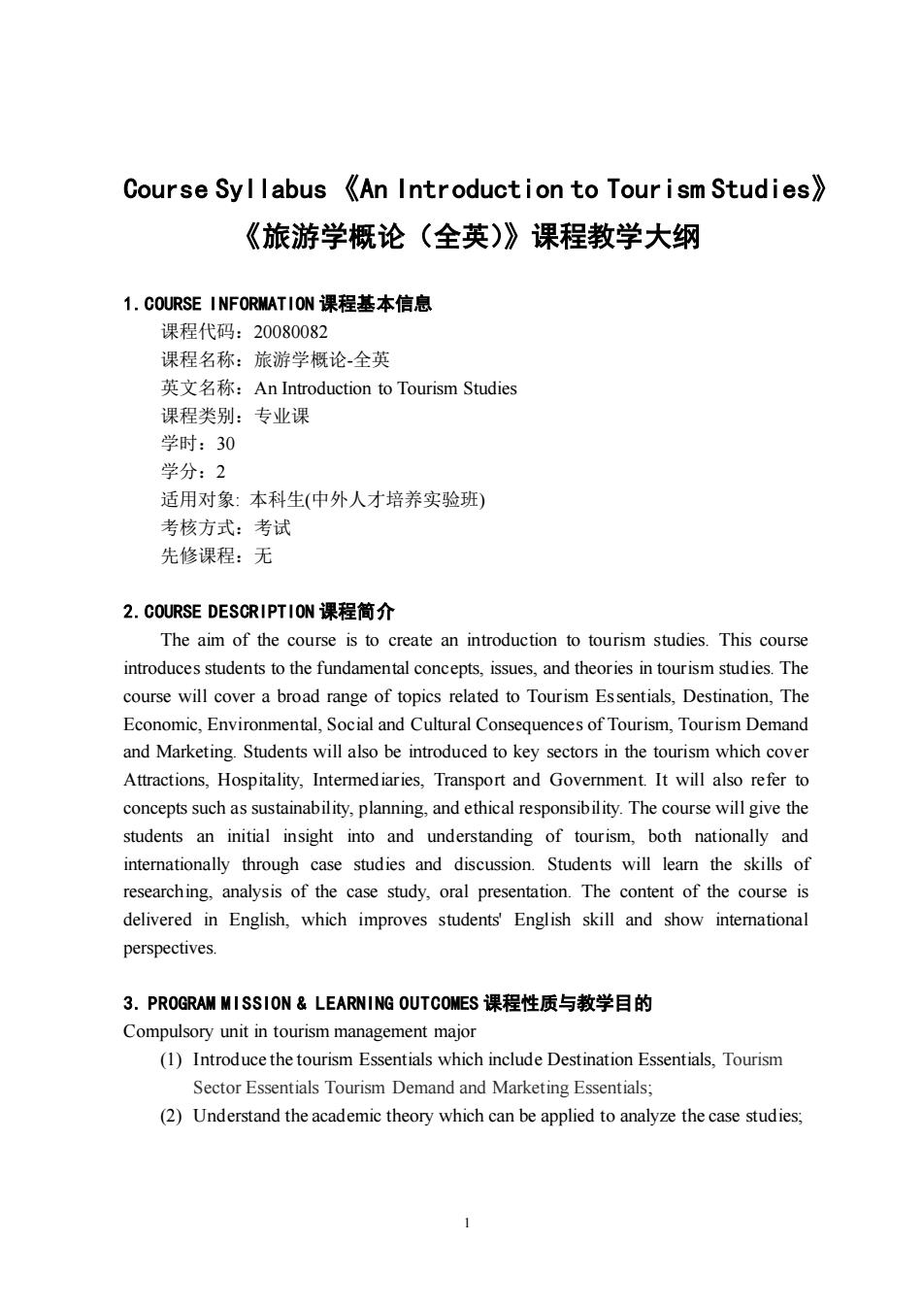
Course Syl labus An Introduction to Tour ism Studies 《旅游学概论(全英)》课程教学大纲 1.COURSE INFORMATION课程基本信息 课程代码:20080082 课程名称:旅游学概论全英 英文名称:An Introduction to Tourism Studies 课程类别:专业课 学时:30 学分:2 适用对象:本科生(中外人才培养实验班) 考核方式:考试 先修课程:无 2.COURSE DESCRIPTION课程简介 The aim of the course is to create an introduction to tourism studies.This course introduces students to the fundamental concepts,issues,and theories in tourism studies.The course will cover a broad range of topics related to Tourism Essentials,Destination,The Economic,Environmental,Social and Cultural Consequences of Tourism,Tourism Demand and Marketing.Students will also be introduced to key sectors in the tourism which cover Attractions,Hospitality,Intermediaries,Transport and Government.It will also refer to concepts such as sustainability,planning,and ethical responsibility.The course will give the students an initial insight into and understanding of tourism,both nationally and internationally through case studies and discussion.Students will learn the skills of researching.analysis of the case study,oral presentation.The content of the course is delivered in English,which improves students English skill and show intemational perspectives. 3.PROGRAM MISSION&LEARNING OUTCOMES课程性质与教学目的 Compulsory unit in tourism management major (1)Introduce the tourism Essentials which include Destination Essentials,Tourism Sector Essentials Tourism Demand and Marketing Essentials; (2)Understand the academic theory which can be applied to analyze the case studies
1 Course Syllabus 《An Introduction to Tourism Studies》 《旅游学概论(全英)》课程教学大纲 1.COURSE INFORMATION 课程基本信息 课程代码:20080082 课程名称:旅游学概论-全英 英文名称:An Introduction to Tourism Studies 课程类别:专业课 学时:30 学分:2 适用对象: 本科生(中外人才培养实验班) 考核方式:考试 先修课程:无 2.COURSE DESCRIPTION 课程简介 The aim of the course is to create an introduction to tourism studies. This course introduces students to the fundamental concepts, issues, and theories in tourism studies. The course will cover a broad range of topics related to Tourism Essentials, Destination, The Economic, Environmental, Social and Cultural Consequences of Tourism, Tourism Demand and Marketing. Students will also be introduced to key sectors in the tourism which cover Attractions, Hospitality, Intermediaries, Transport and Government. It will also refer to concepts such as sustainability, planning, and ethical responsibility. The course will give the students an initial insight into and understanding of tourism, both nationally and internationally through case studies and discussion. Students will learn the skills of researching, analysis of the case study, oral presentation. The content of the course is delivered in English, which improves students' English skill and show international perspectives. 3. PROGRAM MISSION & LEARNING OUTCOMES 课程性质与教学目的 Compulsory unit in tourism management major (1) Introduce the tourism Essentials which include Destination Essentials, Tourism Sector Essentials Tourism Demand and Marketing Essentials; (2) Understand the academic theory which can be applied to analyze the case studies;
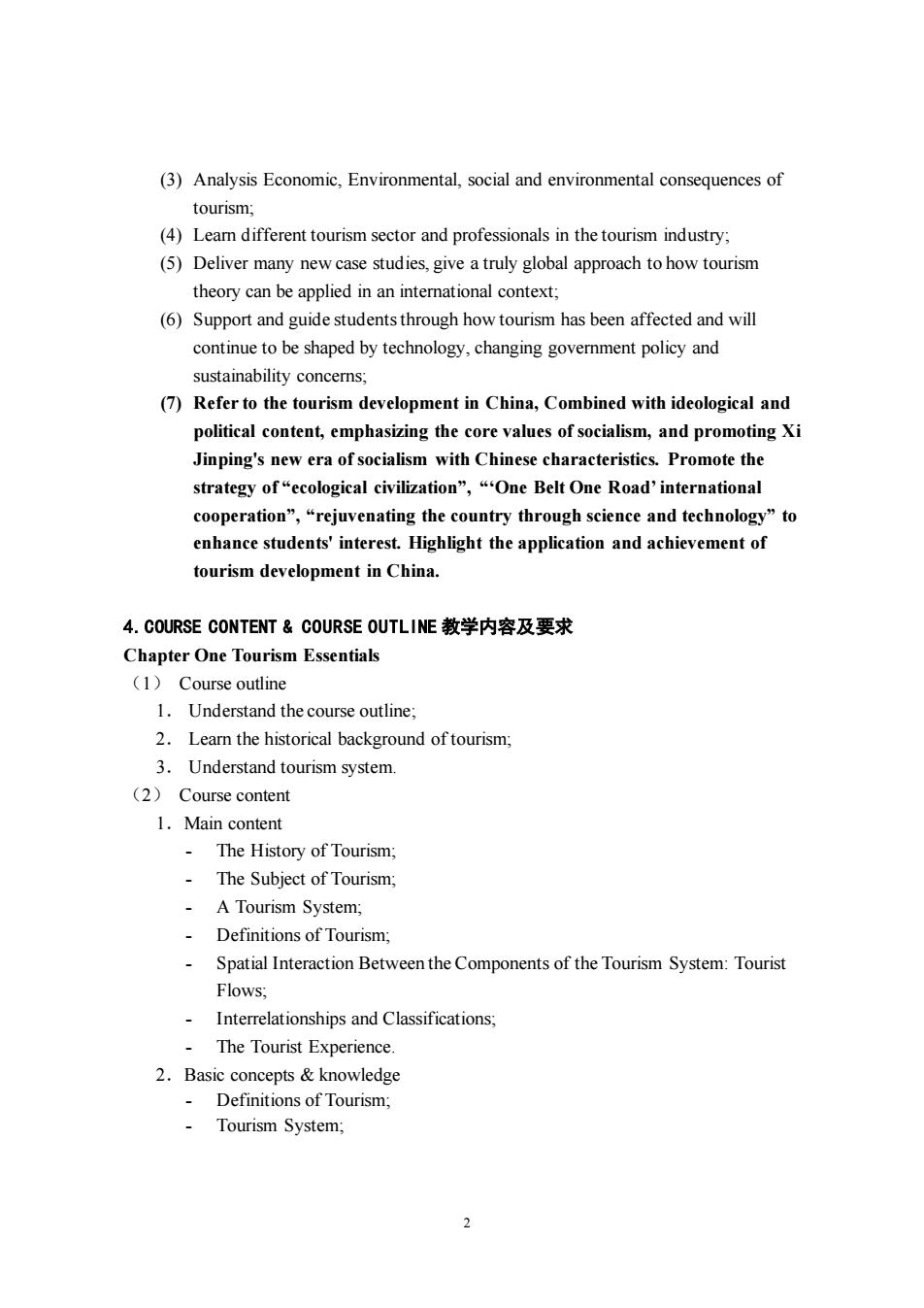
(3)Analysis Economic,Environmental,social and environmental consequences of tourism, (4)Leam different tourism sector and professionals in the tourism industry; (5)Deliver many new case studies.give a truly global approach to how tourism theory can be applied in an international context; (6)Support and guide students through how tourism has been affected and will continue to be shaped by technology.changing government policy and sustainability concerns; (7)Refer to the tourism development in China,Combined with ideological and political content,emphasizing the core values of socialism,and promoting Xi Jinping's new era of socialism with Chinese characteristics.Promote the strategy of"ecological civilization","One Belt One Road'international cooperation","rejuvenating the country through science and technology"to enhance students'interest.Highlight the application and achievement of tourism development in China 4.COURSE CONTENT&COURSE OUTLINE教学内容及要求 Chapter One Tourism Essentials (1)Course outline 1.Understand the course outline: 2.Leamn the historical background of tourism 3.Understand tourism system. (2)Course content 1.Main content The History of Tourism 、 The Subject of Tourism A Tourism System Definitions of Tourism: Spatial Interaction Between the Components of the Tourism System:Tourist Flows: Interrelationships and Classifications; The Tourist Experience. 2.Basic concepts&knowledge -Definitions of Tourism; Tourism System;
2 (3) Analysis Economic, Environmental, social and environmental consequences of tourism; (4) Learn different tourism sector and professionals in the tourism industry; (5) Deliver many new case studies, give a truly global approach to how tourism theory can be applied in an international context; (6) Support and guide students through how tourism has been affected and will continue to be shaped by technology, changing government policy and sustainability concerns; (7) Refer to the tourism development in China, Combined with ideological and political content, emphasizing the core values of socialism, and promoting Xi Jinping's new era of socialism with Chinese characteristics. Promote the strategy of “ecological civilization”, “‘One Belt One Road’ international cooperation”, “rejuvenating the country through science and technology” to enhance students' interest. Highlight the application and achievement of tourism development in China. 4.COURSE CONTENT & COURSE OUTLINE 教学内容及要求 Chapter One Tourism Essentials (1) Course outline 1. Understand the course outline; 2. Learn the historical background of tourism; 3. Understand tourism system. (2) Course content 1.Main content - The History of Tourism; - The Subject of Tourism; - A Tourism System; - Definitions of Tourism; - Spatial Interaction Between the Components of the Tourism System: Tourist Flows; - Interrelationships and Classifications; - The Tourist Experience. 2.Basic concepts & knowledge - Definitions of Tourism; - Tourism System;
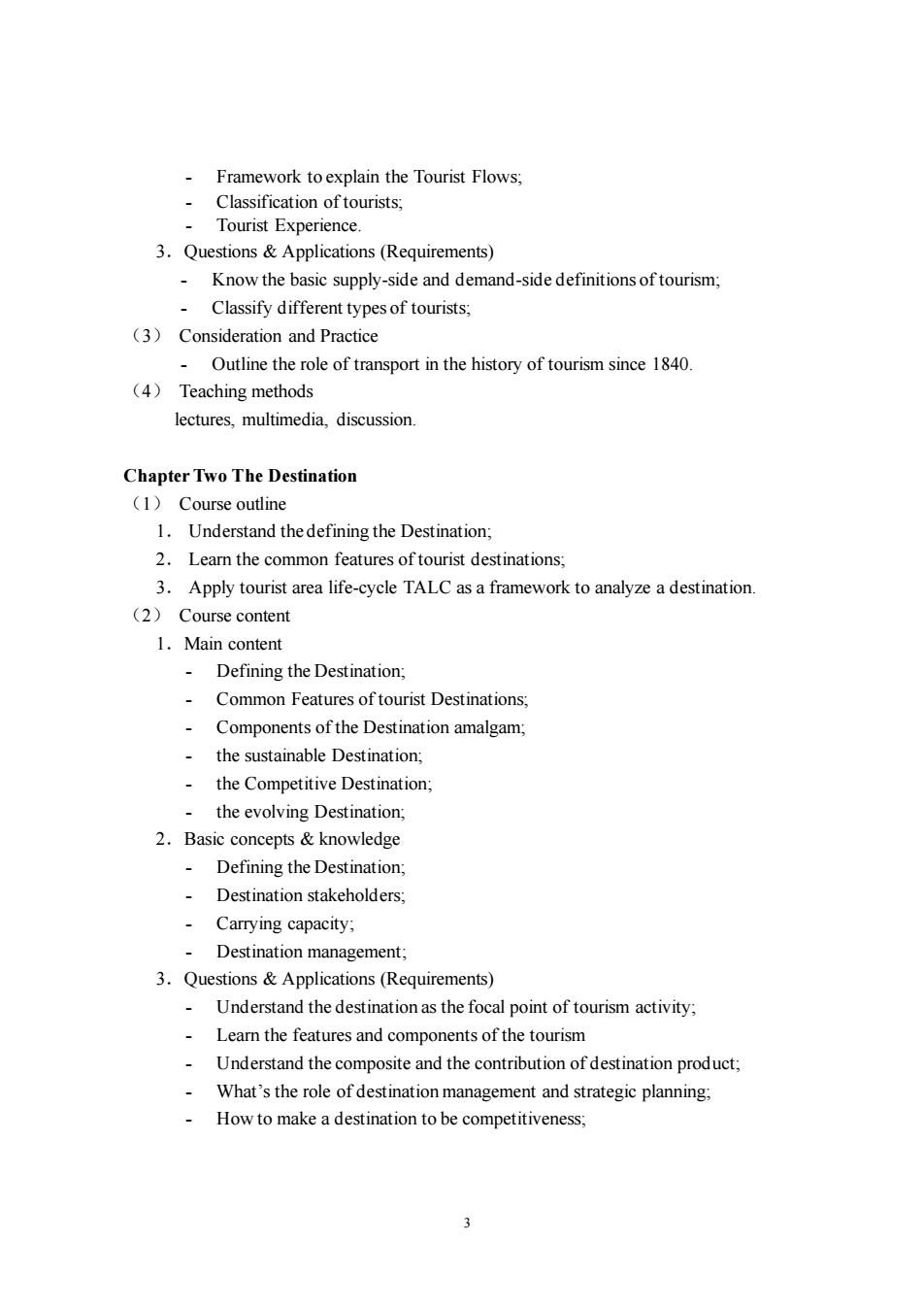
Framework to explain the Tourist Flows, -Classification of tourists: Tourist Experience. 3.Questions&Applications(Requirements) -Know the basic supply-side and demand-side definitions of tourism. Classify different types of tourists; (3)Consideration and Practice Outline the role of transport in the history of tourism since 1840. (4)Teaching methods lectures,multimedia,discussion. Chapter Two The Destination (1)Course outline 1.Understand the defining the Destination; 2.Leamn the common features oftourist destinations. 3.Apply tourist area life-cycle TALC as a framework to analyze a destination. (2)Course content 1.Main content Defining the Destination; Common Features of tourist Destinations: Components of the Destination amalgam the sustainable Destination: the Competitive Destination the evolving Destination: 2.Basic concepts&knowledge Defining the Destination: Destination stakeholders: Carrying capacity: Destination management: 3.Questions Applications(Requirements) Understand the destination as the focal point of tourism activity; Leam the features and components of the tourism Understand the composite and the contribution of destination product: What's the role of destination management and strategic planning How to make a destination to be competitiveness; 3
3 - Framework to explain the Tourist Flows; - Classification of tourists; - Tourist Experience. 3.Questions & Applications (Requirements) - Know the basic supply-side and demand-side definitions of tourism; - Classify different types of tourists; (3) Consideration and Practice - Outline the role of transport in the history of tourism since 1840. (4) Teaching methods lectures, multimedia, discussion. Chapter Two The Destination (1) Course outline 1. Understand the defining the Destination; 2. Learn the common features of tourist destinations; 3. Apply tourist area life-cycle TALC as a framework to analyze a destination. (2) Course content 1.Main content - Defining the Destination; - Common Features of tourist Destinations; - Components of the Destination amalgam; - the sustainable Destination; - the Competitive Destination; - the evolving Destination; 2.Basic concepts & knowledge - Defining the Destination; - Destination stakeholders; - Carrying capacity; - Destination management; 3.Questions & Applications (Requirements) - Understand the destination as the focal point of tourism activity; - Learn the features and components of the tourism - Understand the composite and the contribution of destination product; - What’s the role of destination management and strategic planning; - How to make a destination to be competitiveness;
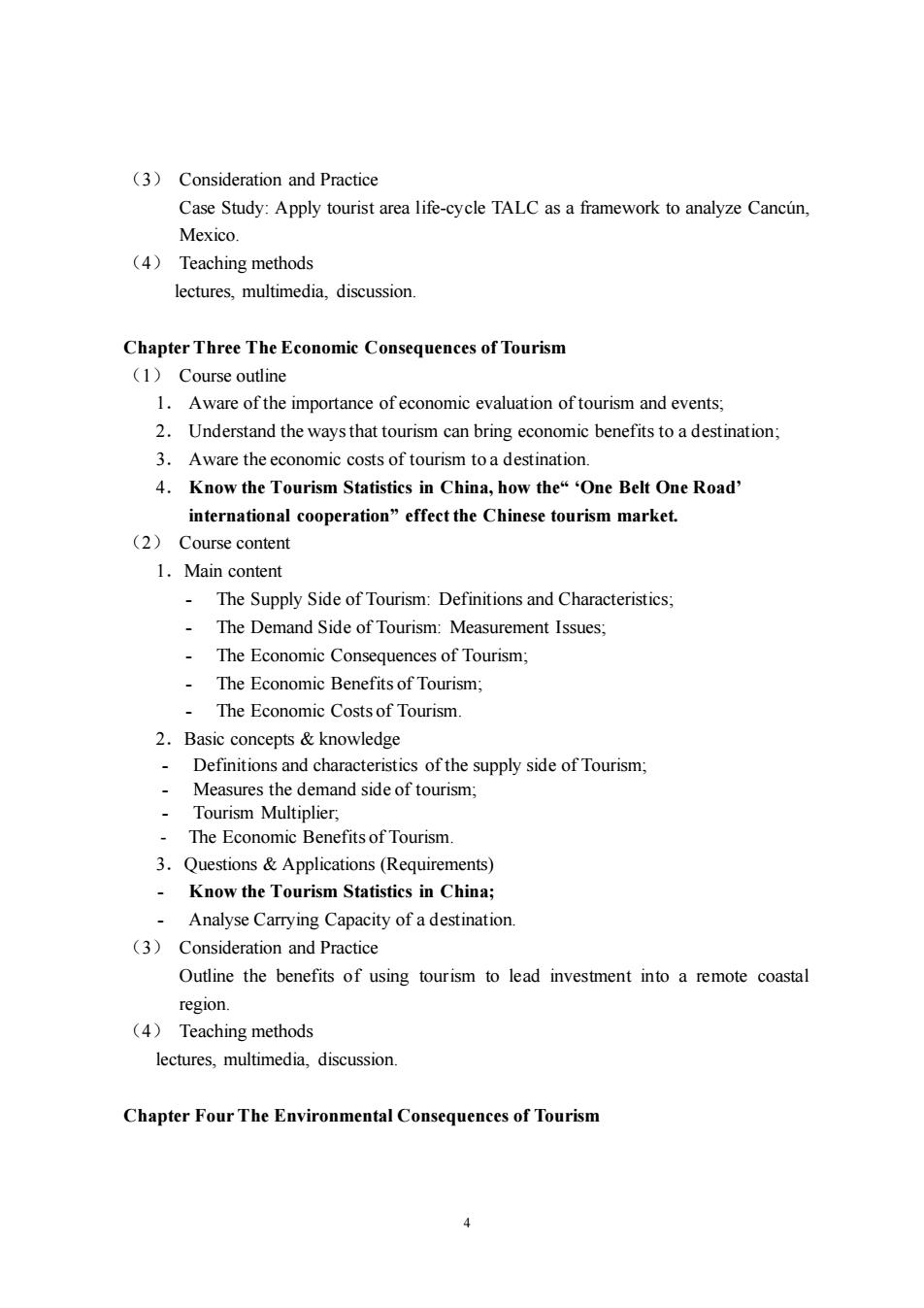
(3)Consideration and Practice Case Study:Apply tourist area life-cycle TALC as a framework to analyze Cancun, Mexico. (4)Teaching methods lectures.multimedia.discussion Chapter Three The Economic Consequences of Tourism (1)Course outline 1.Aware of the importance ofeconomic evaluation of tourism and events, 2.Understand the ways that tourism can bring economic benefits to a destination; 3.Aware the economic costs of tourism toa destination. 4.Know the Tourism Statistics in China.how the"One Belt One Road international cooperation"effect the Chinese tourism market. (2)Course content 1.Main content The Supply Side of Tourism:Definitions and Characteristics; The Demand Side of Tourism:Measurement Issues; The Economic Consequences of Tourism; The Economic Benefits of Tourism The Economic Costs of Tourism. 2.Basic concepts&knowledge Definitions and characteristics of the supply side of Tourism; 、 Measures the demand side of tourism; Tourism Multiplier. The Economic Benefits of Tourism 3.Questions Applications (Requirements) -Know the Tourism Statistics in China: Analyse Carrying Capacity of a destination. (3)Consideration and Practice Outline the benefits of using tourism to lead investment into a remote coastal region. (4)Teaching methods lectures,multimedia,discussion Chapter Four The Environmental Consequences of Tourism 4
4 (3) Consideration and Practice Case Study: Apply tourist area life-cycle TALC as a framework to analyze Cancún, Mexico. (4) Teaching methods lectures, multimedia, discussion. Chapter Three The Economic Consequences of Tourism (1) Course outline 1. Aware of the importance of economic evaluation of tourism and events; 2. Understand the ways that tourism can bring economic benefits to a destination; 3. Aware the economic costs of tourism to a destination. 4. Know the Tourism Statistics in China, how the“ ‘One Belt One Road’ international cooperation” effect the Chinese tourism market. (2) Course content 1.Main content - The Supply Side of Tourism: Definitions and Characteristics; - The Demand Side of Tourism: Measurement Issues; - The Economic Consequences of Tourism; - The Economic Benefits of Tourism; - The Economic Costs of Tourism. 2.Basic concepts & knowledge - Definitions and characteristics of the supply side of Tourism; - Measures the demand side of tourism; - Tourism Multiplier; - The Economic Benefits of Tourism. 3.Questions & Applications (Requirements) - Know the Tourism Statistics in China; - Analyse Carrying Capacity of a destination. (3) Consideration and Practice Outline the benefits of using tourism to lead investment into a remote coastal region. (4) Teaching methods lectures, multimedia, discussion. Chapter Four The Environmental Consequences of Tourism
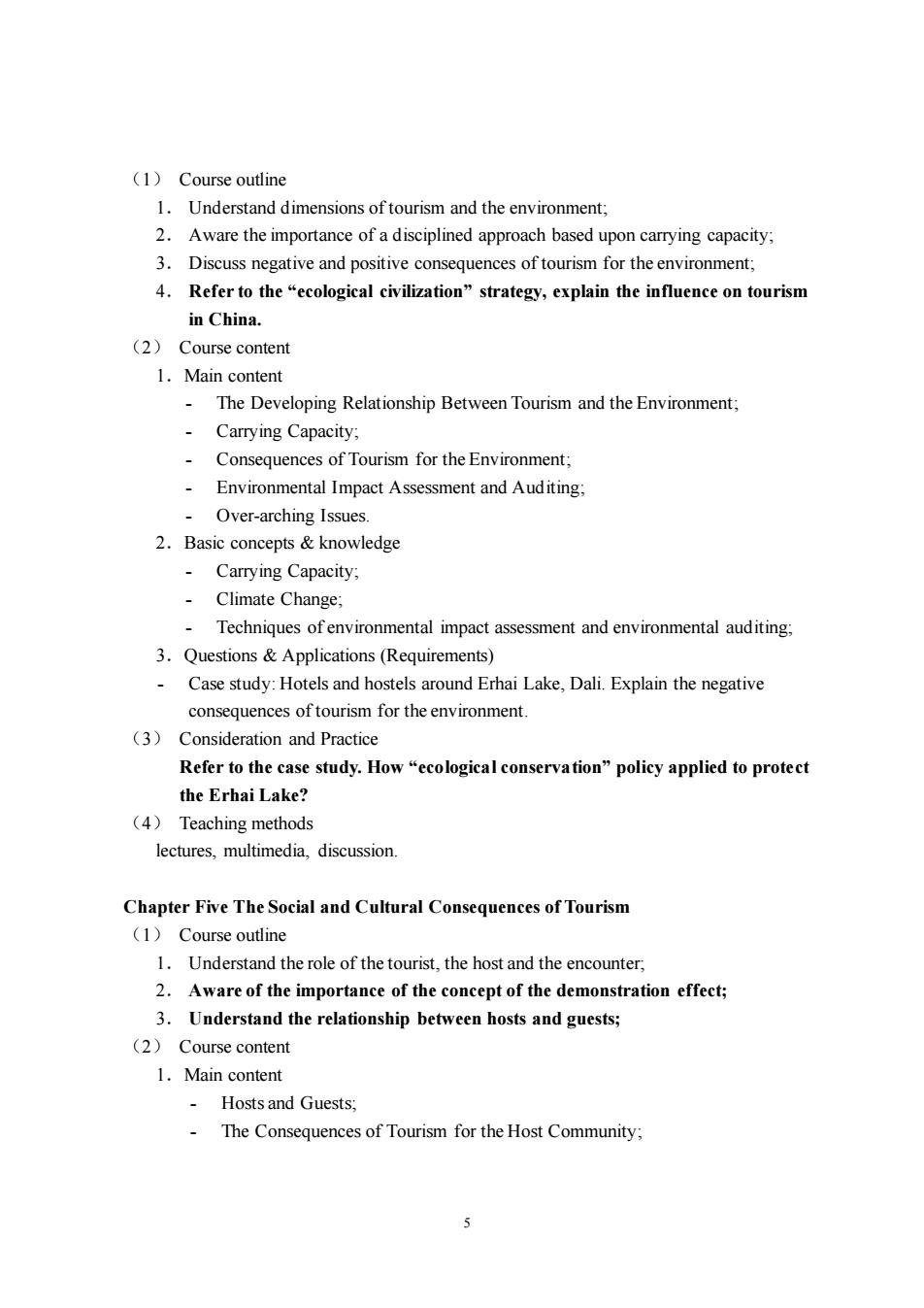
(1)Course outline 1.Understand dimensions of tourism and the environment; 2.Aware the importance of a disciplined approach based upon carrying capacity; 3.Discuss negative and positive consequences of tourism for the environment: 4.Refer to the "ecological civilization"strategy,explain the influence on tourism in China. (2)Course content 1.Main content The Developing Relationship Between Tourism and the Environment: Carrying Capacity; - Consequences of Tourism for the Environment Environmental Impact Assessment and Auditing; Over-arching Issues 2.Basic concepts knowledge Carrying Capacity Climate Change; Techniques ofenvironmental impact assessment and environmental auditing: 3.Questions &Applications(Requirements) Case study:Hotels and hostels around Erhai Lake,Dali.Explain the negative consequences of tourism for the environment. (3)Consideration and Practice Refer to the case study.How "ecological conservation"policy applied to protect the Erhai Lake? (4)Teaching methods lectures,multimedia,discussion. Chapter Five The Social and Cultural Consequences of Tourism (1)Course outline 1.Understand the role of the tourist,the host and the encounter. 2.Aware of the importance of the concept of the demonstration effect; 3.Understand the relationship between hosts and guests; (2)Course content 1.Main content Hosts and Guests; The Consequences of Tourism for the Host Community;
5 (1) Course outline 1. Understand dimensions of tourism and the environment; 2. Aware the importance of a disciplined approach based upon carrying capacity; 3. Discuss negative and positive consequences of tourism for the environment; 4. Refer to the “ecological civilization” strategy, explain the influence on tourism in China. (2) Course content 1.Main content - The Developing Relationship Between Tourism and the Environment; - Carrying Capacity; - Consequences of Tourism for the Environment; - Environmental Impact Assessment and Auditing; - Over-arching Issues. 2.Basic concepts & knowledge - Carrying Capacity; - Climate Change; - Techniques of environmental impact assessment and environmental auditing; 3.Questions & Applications (Requirements) - Case study: Hotels and hostels around Erhai Lake, Dali. Explain the negative consequences of tourism for the environment. (3) Consideration and Practice Refer to the case study. How “ecological conservation” policy applied to protect the Erhai Lake? (4) Teaching methods lectures, multimedia, discussion. Chapter Five The Social and Cultural Consequences of Tourism (1) Course outline 1. Understand the role of the tourist, the host and the encounter; 2. Aware of the importance of the concept of the demonstration effect; 3. Understand the relationship between hosts and guests; (2) Course content 1.Main content - Hosts and Guests; - The Consequences of Tourism for the Host Community;
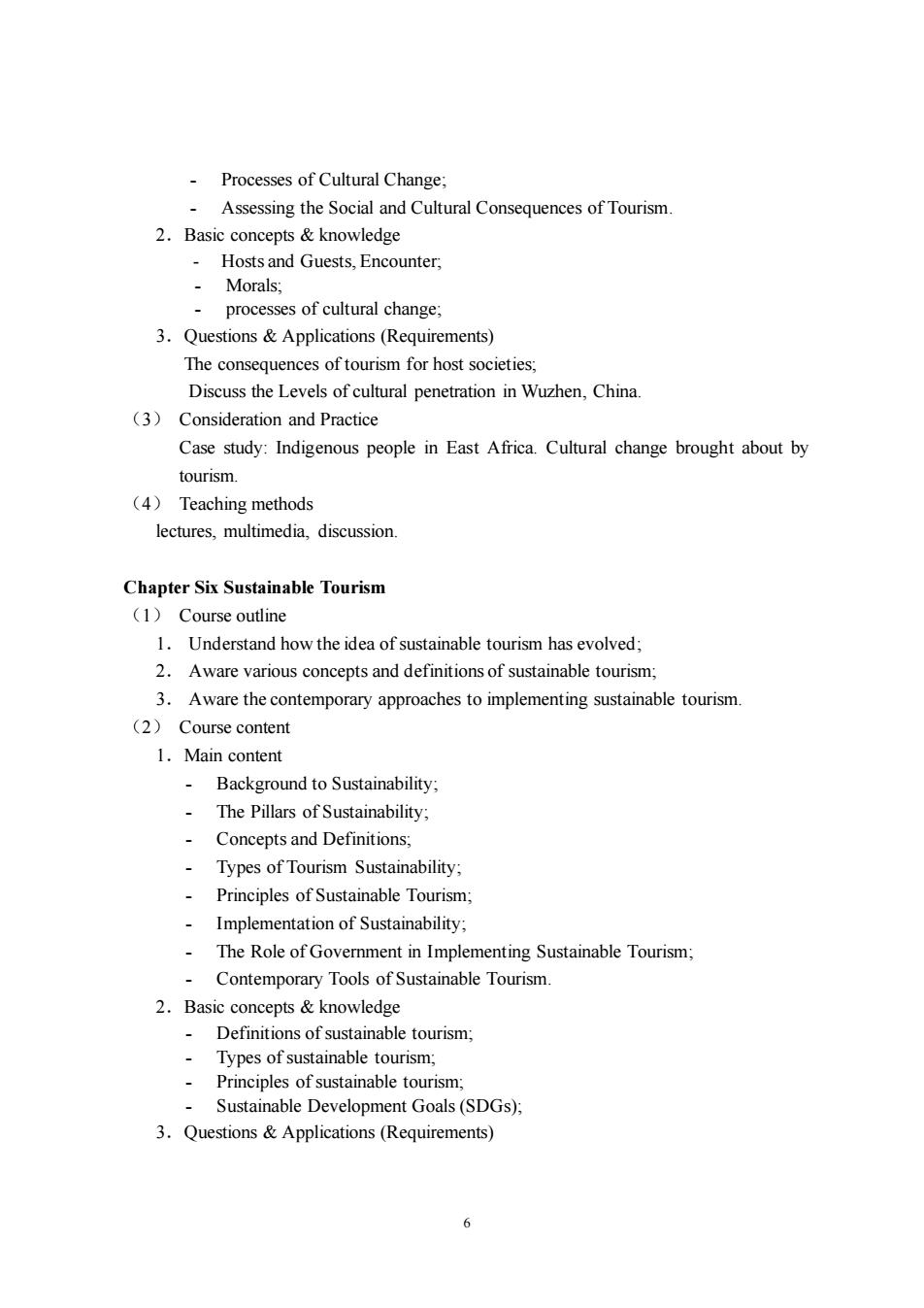
-Processes of Cultural Change; Assessing the Social and Cultural Consequences of Tourism 2.Basic concepts knowledge -Hosts and Guests,Encounter. Morals processes of cultural change; 3.Questions Applications(Requirements) The consequences of tourism for host societies; Discuss the Levels of cultural penetration in Wuzhen,China. (3)Consideration and Practice Case study:Indigenous people in East Africa.Cultural change brought about by tourism. (4)Teaching methods lectures,multimedia.discussion Chapter Six Sustainable Tourism (1)Course outline 1.Understand how the idea of sustainable tourism has evolved: 2.Aware various concepts and definitions of sustainable tourism 3.Aware the contemporary approaches to implementing sustainable tourism. (2)Course content 1.Main content Background to Sustainability; The Pillars of Sustainability: Concepts and Definitions 、 Types of Tourism Sustainability Principles of Sustainable Tourism: -Implementation of Sustainability The Role of Government in Implementing Sustainable Tourism; Contemporary Tools of Sustainable Tourism. 2.Basic concepts&knowledge -Definitions of sustainable tourism; Types of sustainable tourism; eiples of sustainable Sustainable Development Goals(SDGs) 3.Questions Applications(Requirements) 6
6 - Processes of Cultural Change; - Assessing the Social and Cultural Consequences of Tourism. 2.Basic concepts & knowledge - Hosts and Guests, Encounter; - Morals; - processes of cultural change; 3.Questions & Applications (Requirements) The consequences of tourism for host societies; Discuss the Levels of cultural penetration in Wuzhen, China. (3) Consideration and Practice Case study: Indigenous people in East Africa. Cultural change brought about by tourism. (4) Teaching methods lectures, multimedia, discussion. Chapter Six Sustainable Tourism (1) Course outline 1. Understand how the idea of sustainable tourism has evolved; 2. Aware various concepts and definitions of sustainable tourism; 3. Aware the contemporary approaches to implementing sustainable tourism. (2) Course content 1.Main content - Background to Sustainability; - The Pillars of Sustainability; - Concepts and Definitions; - Types of Tourism Sustainability; - Principles of Sustainable Tourism; - Implementation of Sustainability; - The Role of Government in Implementing Sustainable Tourism; - Contemporary Tools of Sustainable Tourism. 2.Basic concepts & knowledge - Definitions of sustainable tourism; - Types of sustainable tourism; - Principles of sustainable tourism; - Sustainable Development Goals (SDGs); 3.Questions & Applications (Requirements)
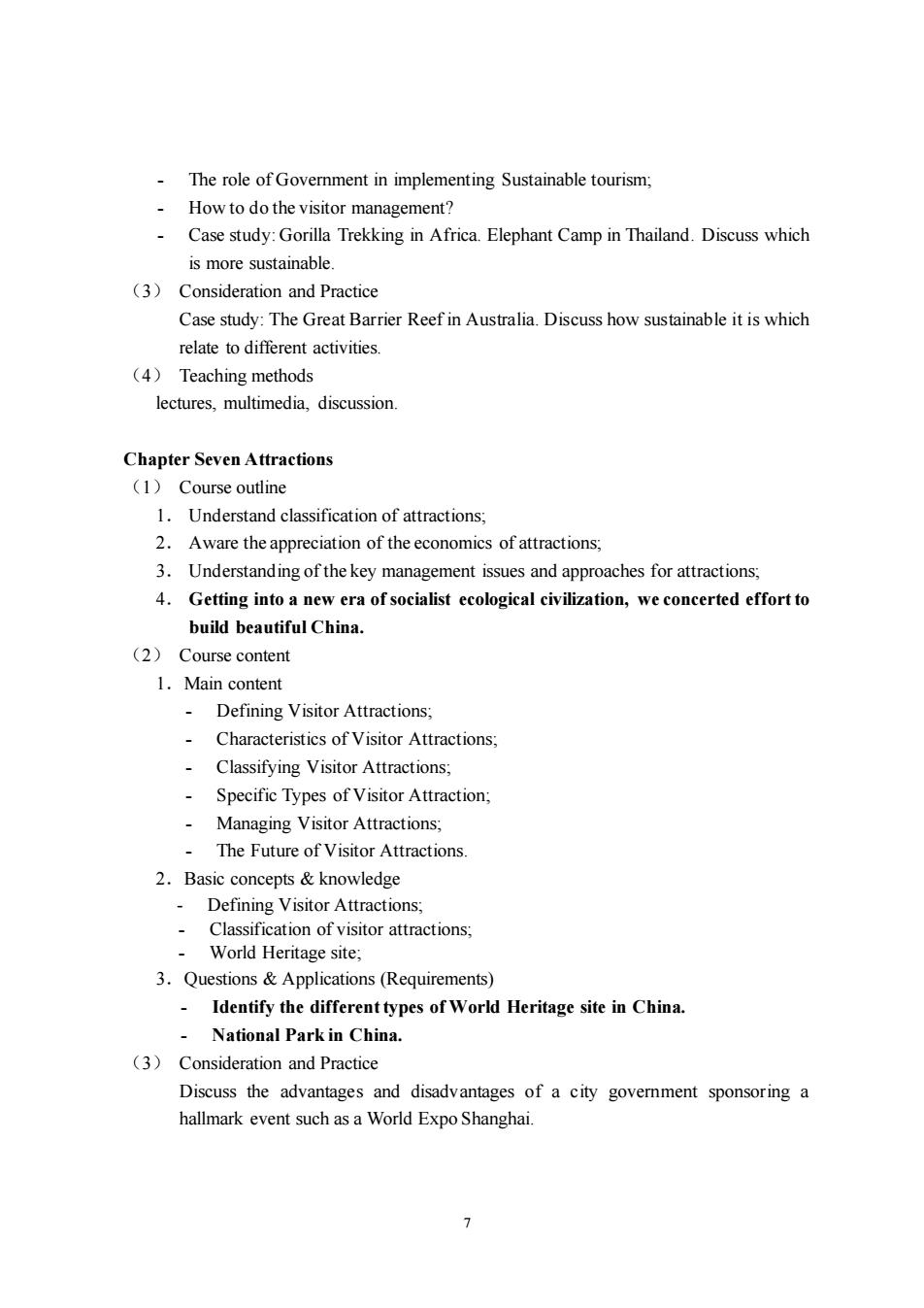
-The role of Government in implementing Sustainable tourism; How to do the visitor management? Case study:Gorilla Trekking in Africa.Elephant Camp in Thailand.Discuss which is more sustainable. (3)Consideration and Practice Case study:The Great Barrier Reef in Australia.Discuss how sustainable it is which relate to different activities (4)Teaching methods lectures multimedia discussion Chapter Seven Attractions (1)Course outline 1.Understand classification of attractions, 2.Aware the appreciation of the economics of attractions; 3.Understanding ofthe key management issues and approaches for attractions 4.Getting into a new era of socialist ecological civilization,we concerted effort to build beautiful China. (2)Course content 1.Main content -Defining Visitor Attractions; Characteristics of Visitor Attractions: 、 Classifying Visitor Attractions. Specific Types of Visitor Attraction 、 Managing Visitor Attractions; The Future of Visitor Attractions 2.Basic concepts knowledge Defining Visitor Attractions Classification of visitor attractions. World Heritage site: 3.Questions&Applications(Requirements) Identify the different types of World Heritage site in China. National Park in China (3)Consideration and Practice Discuss the advantages and disadvantages of a city govemment sponsoring a hallmark event such as a World Expo Shanghai
7 - The role of Government in implementing Sustainable tourism; - How to do the visitor management? - Case study: Gorilla Trekking in Africa. Elephant Camp in Thailand. Discuss which is more sustainable. (3) Consideration and Practice Case study: The Great Barrier Reef in Australia. Discuss how sustainable it is which relate to different activities. (4) Teaching methods lectures, multimedia, discussion. Chapter Seven Attractions (1) Course outline 1. Understand classification of attractions; 2. Aware the appreciation of the economics of attractions; 3. Understanding of the key management issues and approaches for attractions; 4. Getting into a new era of socialist ecological civilization, we concerted effort to build beautiful China. (2) Course content 1.Main content - Defining Visitor Attractions; - Characteristics of Visitor Attractions; - Classifying Visitor Attractions; - Specific Types of Visitor Attraction; - Managing Visitor Attractions; - The Future of Visitor Attractions. 2.Basic concepts & knowledge - Defining Visitor Attractions; - Classification of visitor attractions; - World Heritage site; 3.Questions & Applications (Requirements) - Identify the different types of World Heritage site in China. - National Park in China. (3) Consideration and Practice Discuss the advantages and disadvantages of a city government sponsoring a hallmark event such as a World Expo Shanghai
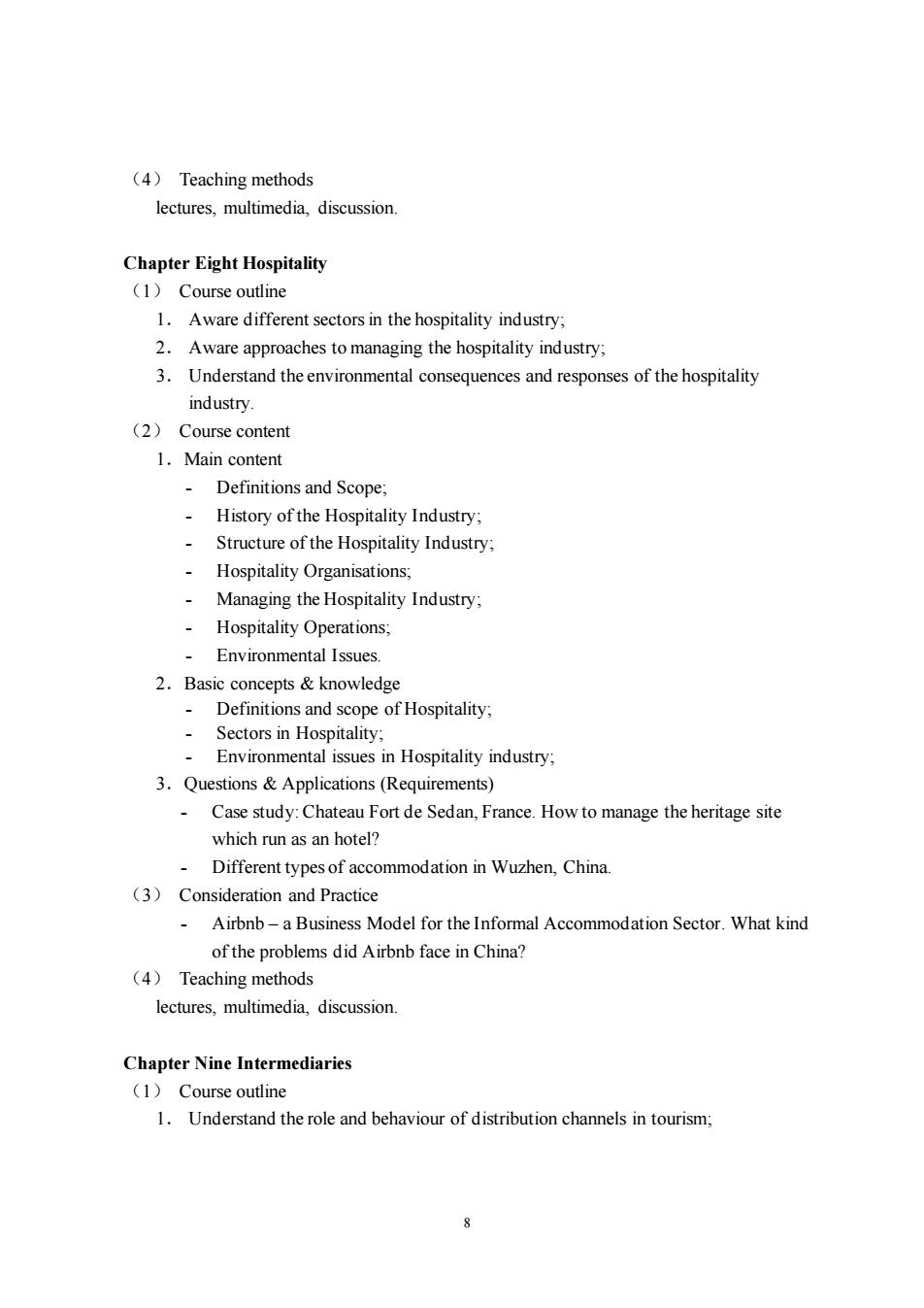
(4)Teaching methods lectures,multimedia,discussion. Chapter Eight Hospitality (1)Course outline 1.Aware different sectors in the hospitality industry; 2.Aware approaches to managing the hospitality industry: 3.Understand the environmental consequences and responses of the hospitality industry. (2)Course content 1.Main content Definitions and Scope; History of the Hospitality Industry: Structure of the Hospitality Industry; 、 Hospitality Organisations Managing the Hospitality Industry; Hospitality Operations Environmental Issues 2.Basic concepts&knowledge Definitions and scope of Hospitality: Sectors in Hospitality; Environmental issues in Hospitality industry; 3.Questions&Applications(Requirements) Case study:Chateau Fort de Sedan,France.How to manage the heritage site which run as an hotel? Different types of accommodation in Wuzhen,China (3) Consideration and Practice Airbnb-a Business Model for the Informal Accommodation Sector.What kind of the problems did Airbnb face in China? (4)Teaching methods lectures,multimedia,discussion. Chapter Nine Intermediaries (1)Course outline 1.Understand the role and behaviour of distribution channels in tourism; 8
8 (4) Teaching methods lectures, multimedia, discussion. Chapter Eight Hospitality (1) Course outline 1. Aware different sectors in the hospitality industry; 2. Aware approaches to managing the hospitality industry; 3. Understand the environmental consequences and responses of the hospitality industry. (2) Course content 1.Main content - Definitions and Scope; - History of the Hospitality Industry; - Structure of the Hospitality Industry; - Hospitality Organisations; - Managing the Hospitality Industry; - Hospitality Operations; - Environmental Issues. 2.Basic concepts & knowledge - Definitions and scope of Hospitality; - Sectors in Hospitality; - Environmental issues in Hospitality industry; 3.Questions & Applications (Requirements) - Case study: Chateau Fort de Sedan, France. How to manage the heritage site which run as an hotel? - Different types of accommodation in Wuzhen, China. (3) Consideration and Practice - Airbnb – a Business Model for the Informal Accommodation Sector. What kind of the problems did Airbnb face in China? (4) Teaching methods lectures, multimedia, discussion. Chapter Nine Intermediaries (1) Course outline 1. Understand the role and behaviour of distribution channels in tourism;
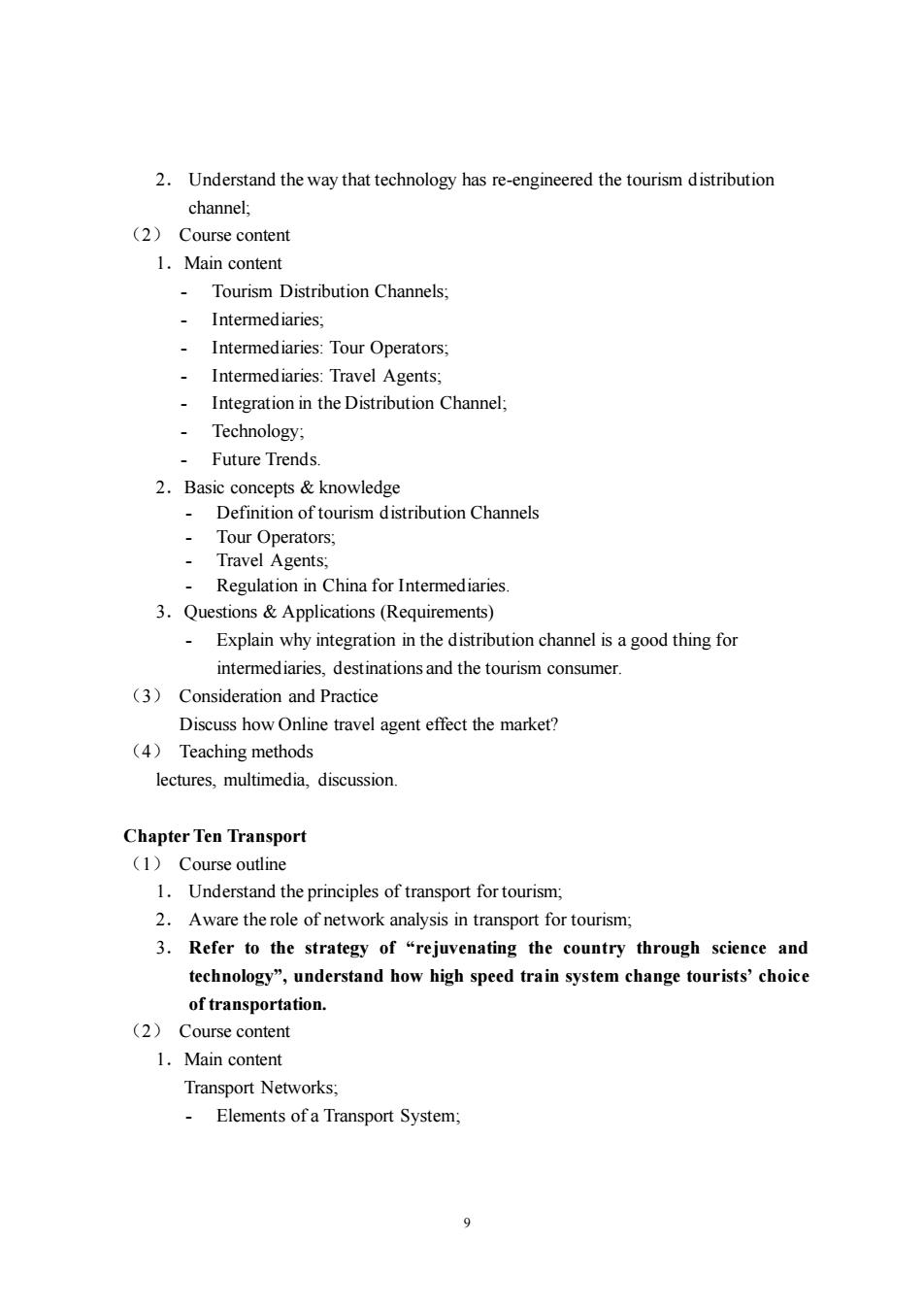
2.Understand the way that technology has re-engineered the tourism distribution channel, (2)Course content 1.Main content Tourism Distribution Channels Intermediaries; Intermediaries:Tour Operators Intermediaries:Travel Agents: Integration in the Distribution Channel; Technology: Future Trends 2.Basic concepts knowledge -Definition of tourism distribution Channels Tour Or rs 、 Travel Agents Regulation in China for Intermediaries 3.Questions Applications(Requirements) Explain why integration in the distribution channel is a good thing for intermediaries.destinations and the tourism consumer (3)Consideration and Practice Discuss how Online travel agent effect the market? (4)Teaching methods lectures multimedia discussion Chapter Ten Transport (1)Course outline 1.Understand the principles of transport fortourism: 2.Aware the role of network analysis in transport for tourism; 3.Refer to the strategy of "rejuvenating the country through science and technology",understand how high speed train system change tourists'choice of transportation (2)Course content 1.Main content Transport Networks; Elements ofa Transport System;
9 2. Understand the way that technology has re-engineered the tourism distribution channel; (2) Course content 1.Main content - Tourism Distribution Channels; - Intermediaries; - Intermediaries: Tour Operators; - Intermediaries: Travel Agents; - Integration in the Distribution Channel; - Technology; - Future Trends. 2.Basic concepts & knowledge - Definition of tourism distribution Channels - Tour Operators; - Travel Agents; - Regulation in China for Intermediaries. 3.Questions & Applications (Requirements) - Explain why integration in the distribution channel is a good thing for intermediaries, destinations and the tourism consumer. (3) Consideration and Practice Discuss how Online travel agent effect the market? (4) Teaching methods lectures, multimedia, discussion. Chapter Ten Transport (1) Course outline 1. Understand the principles of transport for tourism; 2. Aware the role of network analysis in transport for tourism; 3. Refer to the strategy of “rejuvenating the country through science and technology”, understand how high speed train system change tourists’ choice of transportation. (2) Course content 1.Main content Transport Networks; - Elements of a Transport System;

-Managing Transport Systems:Demand; 、 Managing Transport Systems:Transport Costs and Pricing; Managing Transport Systems:The Public Sector: Transport Modes for Tourism 2.Basic concepts knowledge Transport networks; Elements of a Transport system Transport Modes for Tourism: 3.Questions Applications(Requirements) Case study:Changi Airport,Singapore;"Fly on weekends"Package Ticket from Eastern China Airlines.Discuss the Transport pricing in these two companies. (3)Consideration and Practice Draw up a balance sheet for the environmental consequences of air travel versus rail travel (4)Teaching methods lectures.multimedia.discussion Chapter Eleven Government and Tourism (1)Course outline 1.Understand why government is involved in tourism, 2.Aware the tourism policy-making process 3.Aware tourism planning is important. 4.Understand the Role of Chinese Government in Tourism (2)Course content 1.Main content The Role of Government in Tourism; Tourism Policy; Government Tourism Organisations: Contemporary Approaches to Integrated Tourism Governance; Tourism Planning. 2.Basic concepts&knowledge Tourism policy; 、 Government tourism organisations: Duty of Ministry re and tourism of the people's republic of China The UN World Tourism Organization; Tourism planning; 10
10 - Managing Transport Systems: Demand; - Managing Transport Systems: Transport Costs and Pricing; - Managing Transport Systems: The Public Sector; - Transport Modes for Tourism. 2.Basic concepts & knowledge - Transport networks; - Elements of a Transport system; - Transport Modes for Tourism; 3.Questions & Applications (Requirements) Case study: Changi Airport, Singapore; “Fly on weekends” Package Ticket from Eastern China Airlines. Discuss the Transport pricing in these two companies. (3) Consideration and Practice - Draw up a balance sheet for the environmental consequences of air travel versus rail travel. (4) Teaching methods lectures, multimedia, discussion. Chapter Eleven Government and Tourism (1) Course outline 1. Understand why government is involved in tourism; 2. Aware the tourism policy-making process; 3. Aware tourism planning is important. 4. Understand the Role of Chinese Government in Tourism. (2) Course content 1.Main content - The Role of Government in Tourism; - Tourism Policy; - Government Tourism Organisations; - Contemporary Approaches to Integrated Tourism Governance; - Tourism Planning. 2.Basic concepts & knowledge - Tourism policy; - Government tourism Organisations; - Duty of Ministry of culture and tourism of the people’s republic of China; - The UN World Tourism Organization; - Tourism planning;